... Na Mawenzi, mlima mrefu sana.
That's how the Kilimanjaro song goes, as we entered the Mawenzi peak basin. In hindsight, this was my favorite day of the trek. But first, the weekly roundup.

Resha has made clear that she hates clouds. William loves clouds. But we'll get to that later.
My cousin/roommate Eugene just got back from playing ship doctor on an Arctic cruise. Technically, it was the Svalbards, but whose counting? Pictures here.
And Sergey has finished the super-overland portion of his now almost year long South and East Africa journey, ending in Namibia. Pictures here.
Which brings us back to this part of Africa.
Today's information session will focus on our accommodations, and specifically, our tents.

The above picture shows our awesome campsite below Mawenzi peak. As you can see, there is quite a variation in the styles of tents used by various outfitters.

We'll being with our tents, which are shown above at Kikelewa Camp. William and I shared the blue "boy" tent, while Resha was alone in the black "girl" tent. They were very spacious, measuring about 6 feet by 6 feet in the inner chamber, with a similar size "porch" area being located between us and the great outdoors.
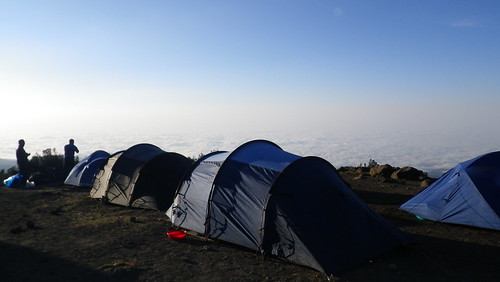
Here they are at Horombo Hut. They measured just under 5 feet in height, so you couldn't quite stand in them, but there was more than enough space in ours for myself, William, and our stuff. And let me tell you, William had a lot of stuff. But we will cover equipment in another post.
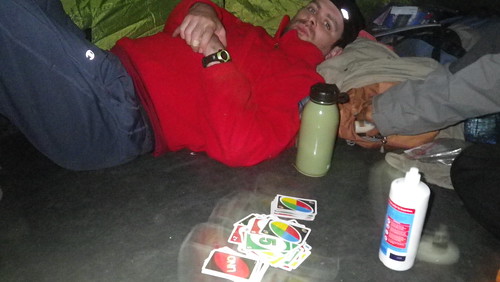
The inside of the tents was spacious enough, in fact, that after dinner on most evenings, the three of us would hang out (usually) in Resha's tent (since she had less clutter), and chat or play Uno. And we played a LOT of Uno. We played so much Uno, that we made up a bunch of complicated rules when the game got too mundane. I wish I could remember them.
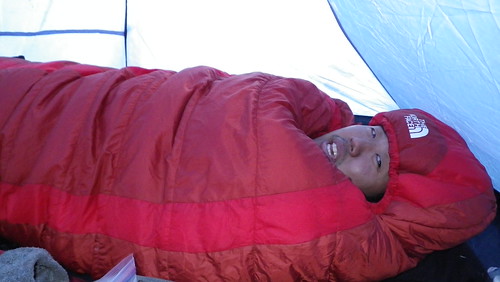
This is me in my mummy sleeping bag, snug as a bug in a rug. The tents were great in that we never got even the slightest bit wet, albeit we were there in the dry season. The temperatures were great too, as I had no problem sleeping in my underwear, although William and Resha wore a bit more clothing at higher elevations.
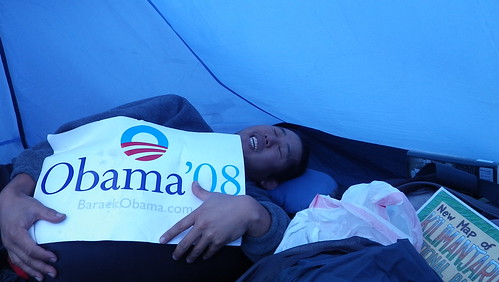
When I felt lonely, however, Barack kept me company. Ahhhhhhh.
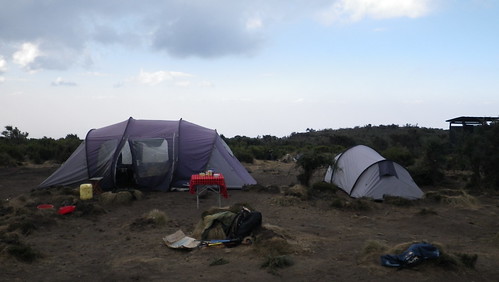
The tents above are those used by our crew of 14. As mentioned in my previous post, the one on the left also served as our meal tent when it was dark or during inclement weather. But that was all done in the center section, which was roughly where you see the screen in the above picture.
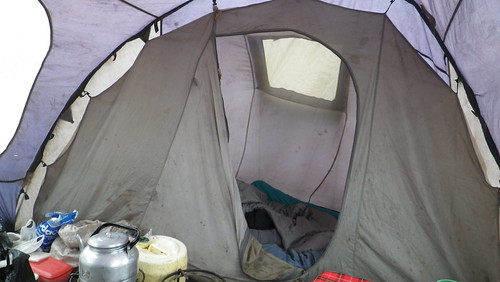
The sides of that tent, however, had the sleeping quarters for the porters. As shown above, each end was divided lengthwise in half by a wall, and each half had it's own door, creating four sleeping compartments in the big tent. Each sleeping compartment held two people, meaning that eight people slept in that tent. The other six slept in the tent to the right of the picture above, i.e., two rows of three across. Like I said, snug as a bug in a rug.
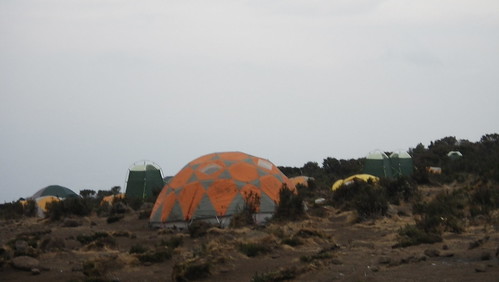
The above domes were the coolest tents we saw. They were massive, about twenty feet in diameter and ten feet high in the middle. We went into one at Kibo Hut inhabited by some French climbers we met, and it was used as the communal area, with chairs and a table in the middle. I was told that after all the activities were done for the day, the porters slept in that tent.

A more typical dome tent. Still pretty big though, as you could clearly stand in the middle.
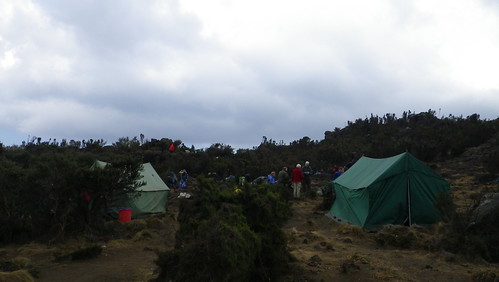
These were mess tents used by our British friends.
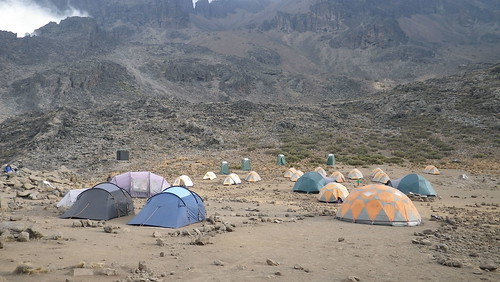
The little tents you see here have more of a story. So, because our journey had been modified by Ronald (we stopped at Kikelewa, instead of going straight from second cave camp to Mawenzi), some people who had made the more conventional journey caught up with us at Mawenzi. It was a group of about 40 Desis from London, and let me tell you, they epitomized exactly the type of people who should NOT have been on the mountain.
It started off auspicious enough, as we first saw the group of about 100 porters rolling in with equipment and setting tents as far as the eye could see. Then, they slowly started to trickle in. The first guy we met was clearly the leader of the group, and he was exhausted. After all, we had done a 4 mile climb that day, but his group had done a 6 miler. And like most parties, they had started the climb immediately after landing, instead of doing a safari first like we did. I cannot stress enough that we chose... wisely in our itinerary.
Well, we chatted for awhile, and he seemed nice enough, and so when the rest of the group started coming in, he excused himself to organize everything. Now, you can imagine the importance of getting as much sleep as possible on this climb. And since everything begins pretty much when the sun comes up, in order to get a full night, you had to sleep right when the sun went down.
Did these people do this? Heck no. In our decidedly worst night of sleep on our journey, much worse than even the zebra stampede and hyena convention at Ngorongoro, these idiots were freaking up all night in the big golf ball looking orange tent above, laughing and joking, playing music. It's like they were at summer camp. From then on, we hated them, and wished a pox on all of their houses.
Luckily, they were spending their acclimatization day at Mawenzi, so after we left camp the next day, we never saw them again. Anecdotally, however, we heard they were a complete disaster on summit day. Apparently, they had greatly underestimated the mountain (and not to be overly sexist, but a large majority of the women in the group were clearly NOT in any sort of physical condition to climb the mountain). Justice, I suppose. Resha and her friend have a name for these type of people, but that's an inside joke that I'll keep close to the vest for now.

This is our tent layout at Kibo Hut. It was definitely the loudest of all the sites, what with groups from both the Marangu and Rongai routes merging at this junction. Still, at least this site was a low level drone which served as a white noise that didn't significantly interfere with our sleep. I will never forget the annoying London Desis of Mawenzi, for as long as I will live.

Which brings us to Mawenzi! So, I left us last week walking into the crater through the clouds. And our ascent to the crater rim and hike in was spectacular.

As we rounded the crest, we looked down to the clouds breaking slightly (or more likely, the crater rim keeping the clouds out) to see the crater bottom. To the right is a water pool bottom, currently dried up and green from the long dry season. If you dig down about two feet, however, as some people did, you could find fresh water.

Apparently the pool bottom itself is very fragile, so Jonas yelled at me was we took this picture. I had been careful not to step on anything green, but apparently that was a no-no also. So, maybe I will have been like Homer Simpson and squished some primitive life that formed the basis of the future. Or maybe I just moved around some mud.

The centerpiece of the Mawenzi camp in the Mawenzi crater is the Mawenzi Tarn Hut. It is the building on the right made, in this incarnation, out of corrugated aluminum, and currently doubles as a ranger station. We went inside to see a ranger desk, various equipment, and lofted sleeping quarters.
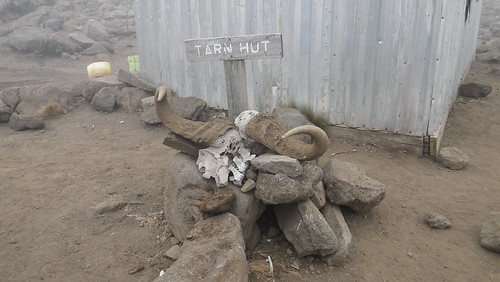
Occasionally, animals do make it this far up, as seen by these water buffalo remnants.

Couldn't resist doing a possessed Lucifer impression. Again.

This was the best shot I got of Mawenzi peak itself, and it was spectacular. Going up literally a thousand feet from Mawenzi camp, it is unscalable as the rocks are way too jagged and loose to even be doing roped climbing. The main peak is to the right, and tops out at 5,149 meters or 16,893 feet, well above anything in the lower 48.

After eating lunch, we went on an acclimatization hike part of the way up Mawenzi itself. So, we ascended up the crater rim again, and this is the view of camp in the distance.

The climb here was pretty steep with a lot of switchbacks. As you can see, it is now very desolate and rocky.

Like in my previous post, we encountered a lot of fire damage, which isn't necessarily a bad thing, as it is a part of the circle of life for vegetation.
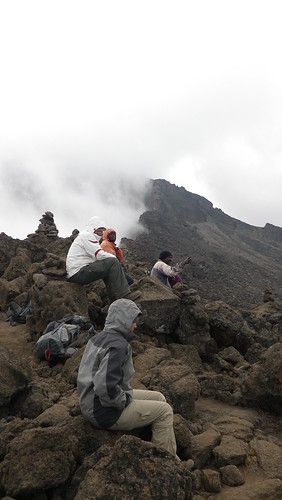
We eventually reach the high point on the crater rim, and just look out to Kibo Hut, and the journey we will make the next day.

That is Kibo peak in the distance, shrouded by clouds, although you can just make out the south side of the peak in the middle. Kibo Hut is just about where the peak meets the Saddle and clouds in the photo.
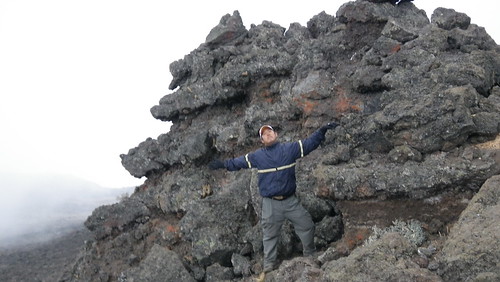
Awesome volcanic rocks.

The cool thing about this part of the mountain, actually, was that the walls of the crater were at such a high elevation, that there were actually different weather patterns mere meters apart. Here, you can see that the crater rim stops the wet clouds to the left, and that it is almost bone dry to the right. We just sat there and watched the cloud hit the rim and go vertical. Amazing.
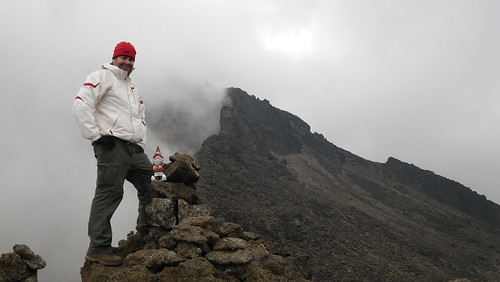
This is the photo that got William in the Virginia Tech alumni magazine. Hope that doesn't end up being his 15 minutes of fame.
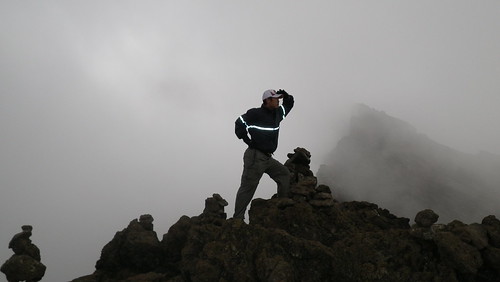
Long distance pose.

I'm falling down the edge of the cliff pose.

I'm tackling William off the mountain pose. Yes, I admit it is slightly gay. We're at 15,000 feet. My brain isn't firing on all cylinders.
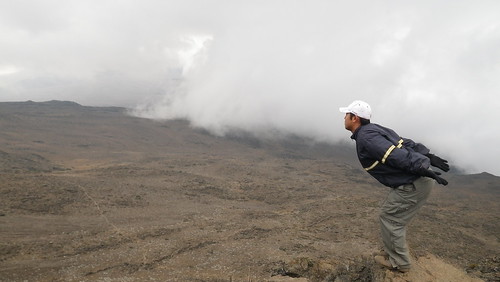
In fact, I am so cuckoo that I threaten to launch myself several hundred feet down. To give you and idea of our height, that faint line on the left side is the path we will take the next day.

Having had enough fun for one day...

... we head on back down to camp.
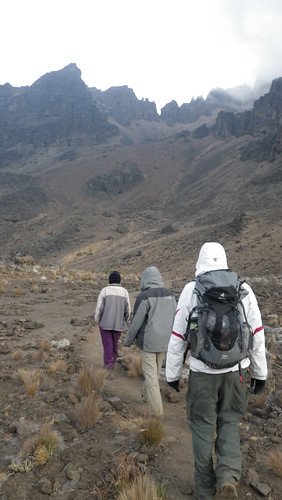
As we reenter the crater, Mawenzi again spectacularly appears.

Apparently, we took a different route on the descent, however, as tons of rock messages have been left in the volcanic dirt. Which makes sense, since the lack of wind in the crater means these rocks aren't moving, pretty much for eternity.
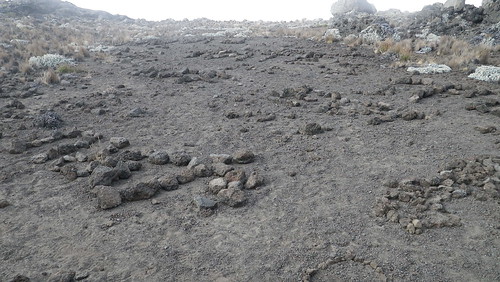
More messages in a... rock.
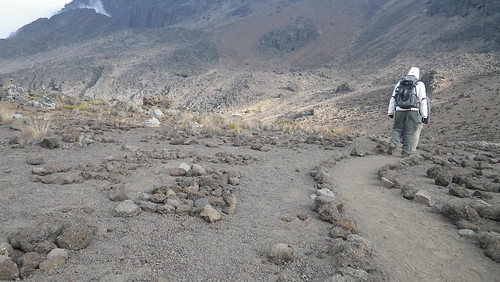
And as we come around the bend, we come back to where we started.
Until next week...
No comments:
Post a Comment